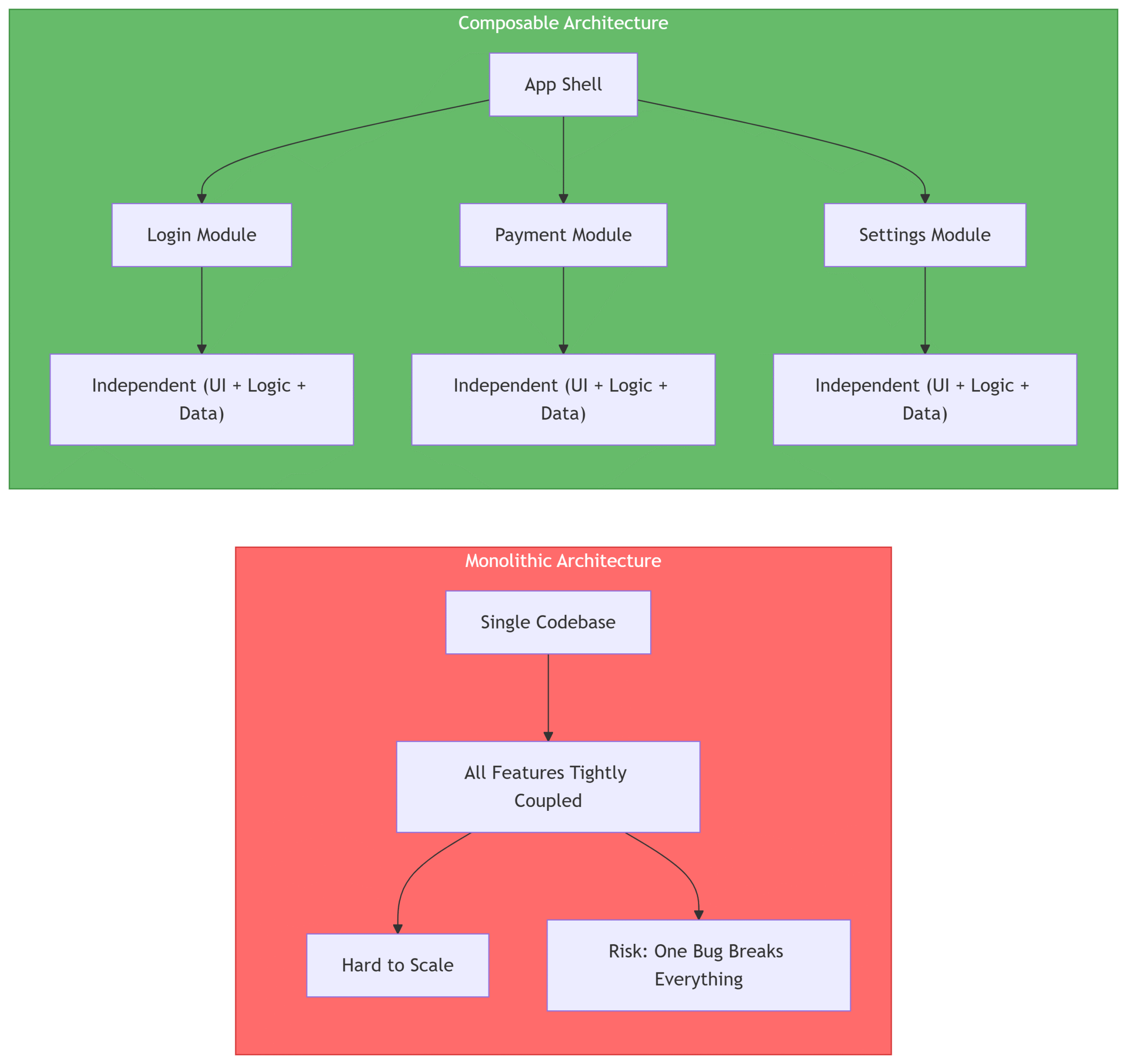Introduction
Mobile apps aren’t just about speed or sleek UIs anymore.
They’re ecosystems.
And how you architect them can either fuel your product’s growth, or drown your team in tech debt.
Let’s be real for a second: most mobile apps start as small, focused projects. But fast-forward a few months (or a couple viral spikes), and suddenly you’re juggling dozens of features, multiple devs, maybe even cross-platform versions.
Sound familiar?
This is exactly where traditional app development starts to break down.
Enter: Composable Architecture, one of the most exciting new computing innovations that’s transforming the future of modular app development.

Think of it as the grown-up version of coding features. It’s not just about building things that work, it’s about building them to evolve, scale, and be reused without headaches.
A great example?
Just look at teams adopting composable architecture in iOS or Android. They’re not refactoring monoliths every quarter—they’re shipping fast, testing easily, and scaling smarter.
Why?
Because modular app architecture changes the game.
Whether you’re knee-deep in SwiftUI, experimenting with Jetpack Compose, or even planning a micro frontend mobile app, modular thinking is becoming non-negotiable.
And here’s the kicker:
It’s not just a dev trend, it’s a competitive edge.
In this blog, we’ll break down what composable architecture means, how it powers scalable apps, and how you can start using it to build apps that don’t fall apart the moment your user base explodes.
Let’s dig in.
What is Composable Architecture?

Okay, so let’s break it down.
Composable architecture is exactly what it sounds like: grouping your mobile app into pieces, modular and reusable, so essentially, like blocks of LEGO in your digital world.
Every feature, screen, or logic piece becomes a self-contained piece, meaning that, build it once, have easy testing, re-use it anywhere, and swap it out or update it when or if you desire, and without ever touching the rest of your app.
It’s not just about being tidy in your code structure – it’s about creating apps that are scalable, maintainable, reusable, and easy to evolve. Understanding what is app architecture at this level is crucial for modern development.
In the rapid development world today, modular app architecture is no longer a nice-to-have; it’s essential.
The “Big Ball of Mud” Problem
Let’s be honest—many apps still follow outdated, tightly coupled structures:
- One bloated codebase, with tangled logic and dependencies
- Changing one screen can break five others
- Onboarding new devs? Painful.
- Testing and scaling? Even worse.
Sound familiar?
Now contrast that with a modular mobile app architecture based on composable principles.
The Composable Way
- Each feature is its own module: isolated, independent, and reusable
- Clear separation of concerns: UI, logic, and state are no longer tangled
- Unidirectional data flow: reduces bugs and makes debugging a breeze
- Composable components: plug-and-play across features and platforms
- Built for testability and scalability from the start
This is the backbone of composable architecture in Android (especially with Jetpack Compose architecture) and modular iOS app architecture (with tools like SwiftUI composable architecture or frameworks like The Composable Architecture (TCA)).
Real-Life Analogy: Think of It Like a Food Truck
You don’t rebuild the whole food truck every time you want to offer a new item. You prep new ingredients, plug in the cooking module (like a fryer or grill), and you’re ready to serve.
Same logic here.
Want to add a new feature? Just plug in a new composable module. Want to refactor a screen? Swap out the component, it won’t crash the entire app.
This mindset is at the heart of micro frontend mobile app design and modern scalable app architecture.
What’s Inside Composable Architecture?
In most implementations (especially on iOS and Android), a composable architecture is built around:
- State – the source of truth for a module or screen
- Actions – what users do or what the system triggers
- Reducers – pure functions that determine how the state changes
- Environment – external systems like APIs, storage, or analytics
You’ll see this clearly in both SwiftUI composable architecture and Jetpack Compose setups. It’s the pattern that brings clarity and control.
How Composable Architecture Connects Independent Modules
When creating an architecture diagram for mobile applications, it’s essential to visualize how these independent modules interact. A well-designed mobile application architecture diagram shows the clear separation between modules while illustrating their communication pathways.

Diagram Breakdown:
- Top Level (Green)
- The mobile app acts as a shell that dynamically loads independent modules.
- Feature Modules (Blue)
- Each module (e.g., Login, Payment, Dashboard) contains:
- UI Components (Orange)
- Business Logic (Orange)
- Data Layer (Orange)
- Modules communicate via well-defined interfaces (APIs/contracts).
- Each module (e.g., Login, Payment, Dashboard) contains:
- Key Traits Illustrated:
- Isolation: Modules can be developed/tested independently.
- Reusability: The Same module (e.g., Auth) can be used across apps.
- Scalability: New modules can be added without touching existing code.
Composable vs. Traditional Architectures
| Aspect | Monolithic | Layered (MVVM/MVC) | Composable |
| Code Structure | Single, tightly coupled | Separation of concerns | Independent modules |
| Scalability | Difficult | Moderate | Highly scalable |
| Team Workflow | Bottlenecks | Better than monolithic | Parallel development |
| Maintenance | High risk of breakage | Moderate | Low risk, easy updates |
Not Just for Big Teams
You might think this sounds great for big tech teams, but here’s the thing:
Modular architecture in iOS and Android isn’t just for FAANG-level apps. Small teams and solo devs often get the biggest wins because modular thinking lets you move faster with fewer people.
If your app is growing or you’re planning cross-platform support, modular app development isn’t optional. It’s your best bet for avoiding long-term headaches.
Let’s explore characteristics of composable architecture.👇
Key Characteristics of Composable Architecture
Now that we have spoken about what composable architecture is, let us narrow down on what makes it powerful and why many teams leverage it for modular app development.
Ultimately, composable architecture is more than just a highly attractive word- it is a great strategy by which mobile apps can be developed that are easier to manage, scale, and evolve.
As one of the leading new computing innovations in mobile development, it’s reshaping how we think about the architecture of mobile apps.
If you’re just starting in mobile development, it’s important to understand how composable architecture fits into the broader custom software development process.
Check out The Complete Custom Software Development Guide For Beginners to learn the fundamentals.
Below are the basic properties that outline how a well-structured modular app architecture is to be understood:
- Modularity
Each part of your app, whether it’s a login screen, a payment flow, or a notification handler, is its self-contained module. That means:
- Everyone on the team can be working on different feature parts of the app without stepping on each other’s toes.
- The features are decoupled, so one module breaking doesn’t crash the whole app.
This is a key principle in both iOS modular architecture and composable architecture Android projects.
- Reusability
Build it once. Use it anywhere.
Whether you are adding a new feature, deploying a different application, or scaling to a different platform, reusable components allow you to:
- Share logic and UI elements across multiple apps or platforms.
- Reduce duplication and cut development time.
- Maintain consistent behavior across your ecosystem.
This is especially powerful in SwiftUI composable architecture, where views and logic can be ported across projects with minimal friction.
- Scalability
Here’s where composable architecture shines.
As your app grows, with more features, more users, more platforms, you don’t want to refactor the whole thing every time. With a scalable web app architecture (or mobile, for that matter), you can:
- Add new modules without disrupting existing ones.
- Scale teams by assigning ownership over specific modules.
- Evolve and optimize different parts of your app independently.
This principle aligns with micro frontend mobile app strategies, where each “mini app” or feature can be deployed and managed individually.
- Interoperability
Modules don’t exist in silos. They should be talking to one another.
And with clearly defined interfaces and contracts, you can initiate communication with each other, with respect to which language or which platform. This opens the door for:
- Better API design.
- Cross-platform integration (iOS ↔ Android).
- Swappable implementations (e.g., local vs. remote data sources).
In both modular iOS app architecture and Android, this is what enables smooth scaling and feature experimentation.
- Flexibility
Things change fast. Markets shift. Features evolve. Bugs happen.
Composable architecture allows your app to adapt without friction:
- Add or update modules without breaking the core app.
- Swap out internal logic (e.g., replacing a login provider) with minimal impact.
- Keep moving fast without sacrificing stability.
This flexibility is important if we are running a complex product or an MVP that has no budget.
By having these attributes, composable architecture acts as the equivalent of not just a tech pattern, but a specific prescription on how to architect the software embodied not just by being future-proof and team-oriented, but also user-centric.
Understanding Mobile Architecture Through Visual Documentation
When teams ask “what is app architecture” in practice, the answer often comes through visual documentation. Creating a comprehensive mobile application architecture diagram helps developers understand how different components interact, making it easier to implement composable patterns effectively.
Composable Architecture vs. Monolithic Architecture

Let’s face it: most legacy apps are built like giant puzzles with no clear edges.
We’re talking about monolithic architecture, where everything is bundled together, tightly coupled, and often painful to maintain.
Now, compare that with the fresh, flexible mindset behind composable architecture, and the difference is night and day.
Let’s break down the battle: Composable vs. Monolithic.
Monolithic Architecture: The Old Way
Think of it like building a house with all the rooms glued together. Sure, it works… until you want to upgrade the kitchen or knock out a wall. Then the whole structure shakes.
Here’s what makes monolithic apps problematic:
- Tight coupling: Logic, UI, and data layers are often deeply intertwined.
- Hard to scale: Adding new features can impact unrelated parts of the app.
- Poor modularity: Every update requires digging through one massive codebase.
- Difficult testing: You often need to boot up the entire app just to test one function.
- Slow team velocity: Devs step on each other’s toes, and merging code becomes a nightmare.
This architecture often kills productivity, especially in teams trying to move fast or manage multiple platforms.
Composable Architecture: The Modern Solution
Now, enter composable architecture, the smarter way to build apps with modular app architecture at the core.
Imagine constructing an app with plug-and-play modules. Want to update the search? Swap out the search module. Want to test notifications? Spin up just that module, no full app boot-up required.
Here’s why it’s a better fit for today’s dev landscape:
- Decoupled design: Each module handles a specific feature or function independently.
- Faster development cycles: With modular app development, teams can work in parallel and deploy features faster.
- Reusable components: The same module can be reused across multiple apps or screens.
- Built for scale: New features or platforms (like a watch app or tablet UI) can be added without rewriting the core.
- Test-friendly structure: You can test each module in isolation, dramatically reducing QA time.
It’s not just about clean code, it’s about building software that can evolve as your product grows.
Understanding the architecture of mobile apps at this level is what separates maintainable codebases from technical debt nightmares.
Whether you’re developing for iOS, Android, or both, choosing the right platform is step one. Not sure where to begin? Here’s a Guide to Choosing The Right Platforms to Develop Mobile Apps.
Real-World Impact: From MVPs to Scalable Systems
Startups love composable architecture because it supports quick iterations. Enterprises love it because it’s how you build a scalable web app architecture or modular mobile app that doesn’t collapse under complexity.
Even micro frontend mobile app approaches lean on the same principle: break the app into autonomous units that are easier to build, test, and deploy independently.
It’s all about long-term sustainability.
Why Composable Wins
| Feature | Monolithic Architecture | Composable Architecture |
| Modularity | ❌ Minimal | ✅ Core Principle |
| Scalability | ❌ Challenging | ✅ Built-in |
| Team Collaboration | ❌ Slower & Risky | ✅ Parallel Development |
| Testing & Debugging | ❌ Complex, High Friction | ✅ Easy, Isolated Modules |
| Feature Updates & Refactors | ❌ Risky & Time-Consuming | ✅ Safe, Targeted Changes |
If you’re serious about building apps that scale gracefully, ship faster, and stay maintainable, then modular app architecture and composable architecture aren’t optional. They’re the future.
Composable architecture works well in both hybrid and native stacks. Not sure which route to take? Read Hybrid vs. Native Apps: Pros and Cons for Your Business before you decide.
Advantages of Composable Architecture
Transitioning to composable architecture isn’t merely an upgrade to your technology; it’s a change for practice and action.
Whether you are building a next-gen mobile app, a scalable web app, or a micro frontend mobile app, the learning curve has some very tangible benefits.
Here are some reasons why teams that are thinking ahead are leveraging app modularity as their app development toolbox for building fast, flexible, and future-proof apps:
- Enhanced Agility and Speed
Speed is key in the competitive landscape we have today.
With a composable architecture, teams can pivot quickly to changes in the market by:
- Adding, removing, or updating individual components without rewriting the whole app.
- Shipping updates faster, because each module is isolated and self-contained.
- Testing new features or UI concepts without affecting the rest of the experience.
And whether you’re using Jetpack Compose architecture on Android or SwiftUI composable architecture on iOS, that modular flexibility becomes agility in the real world.
- Cost-Effectiveness
Let’s talk bottom line.
By following modular app development principles, developers can reuse components across multiple projects or platforms. That means:
- Less time spent rebuilding the same logic or UI patterns.
- Smaller teams can achieve more.
- Accelerated MVP development without losing scalability.
This is particularly valuable for startups and lean dev teams requiring speed without accumulating tech debt.
- Improved Scalability
Need to handle a growing user base or add new services? No problem.
Composable architecture is built to scale, literally. Since each module is independent, you can:
- Scale individual features (like chat, payments, or analytics) based on demand.
- Allocate resources more efficiently.
- Add new modules as your app evolves, without re-architecting everything.
Whether you’re building a modular iOS app architecture or a scalable web app architecture, this kind of targeted scalability is a game-changer.
Building features modularly means you can focus on what really matters. Need a checklist? Don’t miss this essential guide on key features of a successful mobile app.
- Seamless Integration
Modern apps don’t live in isolation; they need to connect with CRMs, payment gateways, analytics tools, and more.
Composable architecture supports API-first, plug-and-play integrations, making it easy to:
- Add third-party services without disrupting core systems.
- Isolate and test integrations in their own modules.
- Replace outdated services with minimal refactoring.
This makes it ideal for micro frontend mobile app strategies where each piece of the app interacts with different APIs or services.
If your app spans mobile and web, responsive design becomes part of the architecture conversation. Here’s why responsive web design still matters in 2025.
- Future-Proof Design
Tech changes. Fast.
With a modular app architecture, your system is designed to evolve. You can:
- Replace outdated modules with new implementations.
- Swap out entire stacks (e.g., from Firebase to Supabase) without breaking your app.
- Keep your product aligned with user expectations and new technologies.
In both composable architecture iOS and Android contexts, this modularity ensures your codebase stays clean, current, and flexible as new frameworks or tools emerge.
This adaptability is why composable architecture represents one of the most important new computing innovations in mobile development today.
If your app connects with a web-based dashboard or admin panel, choosing the right web platform matters too. Don’t miss this guide to choosing the best platform to create a website.
Developer Happiness & Team Productivity
Let’s not forget the human side.
When developers work in a modular architecture setup:
- They feel more ownership over isolated modules.
- They spend less time debugging unrelated issues.
- Onboarding becomes faster because new devs can work on a single module without learning the whole codebase.
This leads to better morale, cleaner code, and higher team velocity.
In short? Composable architecture isn’t just a “nice pattern”; it’s a practical solution for building software that’s fast to ship, easy to grow, and simple to maintain.
Real-World Examples of Modular App Development Using Composable Architecture
Let’s bring it down from theory and into practice.
You’ve got the concept. You understand the benefits. But what does composable architecture actually look like in the wild?
Here are real-world examples showing how companies and developers are building better mobile experiences using modular app development and composable architecture—on both iOS and Android, and even across platforms.
- iOS Apps with Composable Architecture (SwiftUI + TCA)
Example: E-Commerce App with Product, Cart, and Checkout Modules
In a typical e-commerce app, you might have:
- A Product Listing module
- A Product Details module
- A Shopping Cart module
- A Checkout & Payments module
Using composable architecture in iOS, especially with SwiftUI composable architecture and frameworks like The Composable Architecture (TCA), each of these features can be built as independent modules.
This is what modular iOS app architecture is all about:
- Each module has its own state, actions, reducers, and UI views.
- Teams can work on the Product and Cart modules in parallel, without clashing.
- You can test the checkout flow in isolation without loading the full app.
This kind of modular architecture iOS teams love isn’t just about developer happiness; it’s also about release velocity and stability at scale.
- Composable Architecture Android with Jetpack Compose
Example: Social Media Apps like Snapchat, TikTok-type apps with Feed, Stories, Messages, and Profile Modules
Google’s push for Jetpack Compose architecture makes Android the perfect playground for composable design.
Let’s say you’re building a modular social media app. You can break it into:
- Feed Module – pulls data, manages interactions, and handles UI
- Stories Module – standalone with swipe gestures and media playback
- Messages Module – isolated with its own database/cache
- Profile Module – handles settings, user data, and preferences
Each module is a composable unit, complete with its own ViewModels, state, and navigation.
This approach defines the modern composable architecture that Android developers are moving toward, allowing for:
- Faster builds and deployments
- Easier testing with mock environments
- Reuse of UI components (cards, avatars, etc.) across features
The result? Better performance, cleaner architecture, and scalable modular app development that’s easy to maintain.
- Micro Frontend Mobile App for Cross-Team Development
Example: Travel Booking App by a Multi-Team Organization
In large-scale organizations, especially those building for web and mobile, micro frontend mobile app architecture is gaining popularity.
Consider a travel app broken into:
- Flights Module
- Hotels Module
- Car Rentals Module
- User Account Module
Each team owns a module, deployed and tested independently.
In this setup:
- iOS teams use a composable architecture SwiftUI to build modular UIs.
- Android teams follow modular app architecture using Jetpack Compose.
- Web teams use micro frontends tied to the same APIs as mobile modules.
This architecture makes it possible to:
- Roll out features independently
- Integrate third-party APIs per module
- Maintain clean separation of concerns across platforms
It’s a perfect blend of composable architecture and scalable web app architecture—proving this strategy isn’t limited to just one platform.
Developer Pro Tip
Even indie developers are adopting this pattern.
Why? Because building features like authentication, onboarding, or analytics as modular components means you can:
- Plug them into future apps
- Reuse them across client projects
- Stay DRY (Don’t Repeat Yourself)
Whether you’re using SwiftUI composable architecture or designing modular Android apps with Jetpack Compose, composable thinking is helping devs build faster, scale easier, and ship better products, without burning out.
Real-World Applications of Composable Architecture
Composable architecture is not a theoretical idea; it is a real way that large companies have solved problems.
From music streaming to e-commerce, many companies are using modular app architecture to accelerate their pace, scale more intelligently, and provide better user experiences.
The examples below illustrate how composable architecture empowers these organizations to exist in fast-changing, high-demand ecosystems.

Spotify clearly provides an example of composable architecture, utilizing a microservices-based modular architecture, allowing each service to a specific function: stream music, make playlists, track user activity, handle podcasts, etc.
- With podcasts being added to their platform, Spotify didn’t need to re-architect the entire app.
- Spotify created new modules to add podcast content and distribution, without interfering with existing services.
Through this modular architecture, Spotify can scale and deploy features independently, making its platform extremely resilient and easy to evolve.
Modular app development is convenient when you want to build applications at scale.

Uber’s success does not only stem from an elegant app, but also from the way it was built and structured.
Uber attributes its success to a modular app architecture that contains separate services for each of its core functionalities, for example, ride booking, driver tracking, payments, maps, etc.
- Each service is owned by a specific engineering team.
- New features or updates can be rolled out to one module without affecting others.
This approach fosters rapid innovation and agility, exactly what’s needed in a global platform that’s constantly adapting to new cities, regulations, and user behaviors.
In essence, Uber demonstrates the strength of composable architecture in high-complexity, high-scale environments.

When it comes to delivering seamless user experiences at scale, few do it better than Netflix.
Netflix uses a highly modular and composable architecture across its entire tech stack. Every major feature, from video delivery to recommendations to billing, is treated as a discrete, scalable module.
- When a popular show drops and traffic surges, only the streaming modules are scaled.
- Meanwhile, billing, search, or user account services remain unaffected.
This ability to isolate and scale specific components is the hallmark of true modular app development, and a key reason Netflix remains fast, responsive, and reliable under pressure.

Shopify is built around the composability concept for its developers and the merchants using it.
Shopify allows merchants to construct and customize their store from available library of modules – Finito, an in-house provider, has its own layer of interfaces built for, and developed from Shopify.
- Shopping cart
- Inventory management
- Shipping & tax calculation
- Payment processing
These are composable building blocks that can be configured to match each merchant’s needs. This is a classic use case of modular app architecture that allows for:
- Faster time-to-market
- Greater flexibility
- Low-code/no-code customization
By empowering non-developers with modularity, Shopify showcases the power of composable architecture beyond code, turning it into a platform philosophy.
Key Takeaway:
If tech giants like Spotify, Uber, Netflix, and Shopify are betting big on modular app development, it’s not just because it sounds good; it’s because it works.
They’ve proven that composable architecture leads to:
- Faster development cycles
- Easier scaling
- Independent feature ownership
- Resilience in high-load environments
These real-world success stories show that composable design isn’t just for big tech; it’s an adaptable, scalable approach that can benefit startups, enterprises, and digital product teams alike.
How Boolean Inc. Can Help You Build Smarter with Composable Architecture
You’ve seen the benefits. You’ve read the success stories. Now you might be thinking:
“Okay… so where do we start with composable architecture?”
That’s exactly where Boolean Inc. comes in.
Whether you’re building a mobile app from scratch or looking to untangle a legacy monolith, we help teams design and implement modular app architecture that’s tailored to their product, team, and growth goals.
What We Do:
- Modular Architecture Planning
We don’t just toss buzzwords around. We work with your team to define clear module boundaries, choose the right tech stack, and set up scalable foundations, whether it’s for SwiftUI composable architecture, Jetpack Compose architecture, or cross-platform systems.
- Composable Architecture Implementation
Need to break your app into independent, testable, reusable components? We’ve done it for startups and enterprise clients alike. From feature modules to micro frontends, we bring battle-tested patterns to your team.
- Legacy Refactoring & Migration
Still running a monolith? We help you transition to a composable system without downtime chaos. Step-by-step, feature-by-feature, with zero disruption to your users.
- Platform-Specific Expertise
We live and breathe both composable architecture and Android, and modular architecture and iOS.
So whether you’re working with Kotlin Multiplatform, SwiftUI, or hybrid stacks, we’ve got the playbook and the dev muscle to help.
Why Teams Trust Boolean Inc.
- Experienced architects & mobile specialists
- Proven success across industries like e-commerce, travel, education, and health tech
- Custom solutions, no cookie-cutter blueprints
- Ongoing support so your team can own the system after handoff
Ready to Build Smarter?
If you’re ready to future-proof your app with composable architecture and want a partner who’s as strategic as they are technical, let’s talk.
👉 Get in touch with Boolean Inc., and we’ll help you unlock the flexibility, speed, and scale your product needs to grow.
Conclusion
Composable architecture isn’t just a trend; it’s the blueprint for modern mobile apps. By adopting modular, reusable, and scalable design principles, you can:
✅ Speed up development with parallel workflows.
✅ Reduce costs by reusing components across projects.
✅ Future-proof your app against changing demands.
Companies like Spotify, Uber, and Netflix have already proven their power. Now, it’s your turn.
Start small. Break one feature into a module. Test it. Scale it.
The future of app development isn’t monolithic; it’s composable.
FAQs
- What is a composable architecture in mobile apps?
Composable architecture is a modular approach to app development where features are built as independent, reusable components, making apps easier to scale, test, and maintain.
- How is a composable architecture different from a monolithic architecture?
Unlike monolithic architecture, where everything is tightly coupled, composable architecture breaks the app into smaller modules, allowing teams to develop and deploy features independently.
- Is a composable architecture suitable for both iOS and Android?
Yes! iOS developers use tools like SwiftUI composable architecture, while Android developers often adopt Jetpack Compose architecture to build modular apps on their respective platforms.
- What are the benefits of modular app development?
Modular app development leads to faster release cycles, better scalability, cleaner code, and easier collaboration across teams, especially in large or growing codebases.
- Can I migrate an existing app to a composable architecture?
Absolutely. You can transition gradually by modularizing one feature at a time, reducing risk, and maintaining a smooth user experience during the migration.







